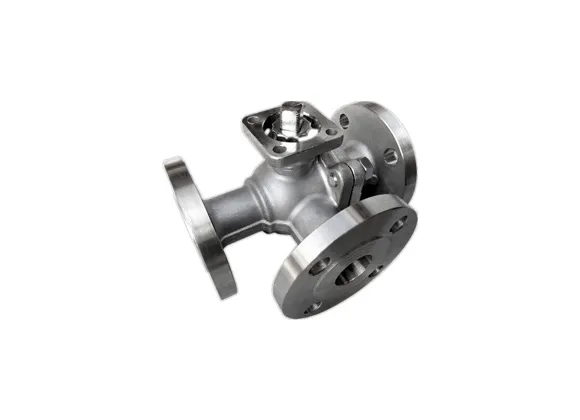May . 12, 2025 11:29
In the world of fluid control systems, a 3 way flanged ball valve plays a crucial role in directing and managing the flow of liquids and gases. Whether you need precise control in an industrial process or a robust solution for high-pressure environments, understanding the 3 way flanged ball valve dimensions and selecting a high pressure 3 way ball valve is essential. This guide explores everything you need to know, from key specifications to installation and maintenance.

A 3 way flanged ball valve is a type of valve designed with three ports, allowing fluid to be redirected in multiple directions. These valves are widely used in industries such as chemical processing, oil and gas, and water treatment due to their durability, efficiency, and versatility.
Multi-Directional Flow Control: The design enables T-port or L-port configurations for different flow directions.
Durable Flanged Ends: The flanged connection ensures a secure and leak-proof installation, making it ideal for high-pressure applications.
Heavy-Duty Material Options: Available in stainless steel, carbon steel, and other durable materials for corrosion resistance.
High Pressure Resistance: A high pressure 3 way ball valve can withstand extreme conditions, making it suitable for industrial use.
Eliminates Multiple Valves: A 3 way flanged ball valve can replace multiple standard valves, reducing complexity in piping systems.
Quick and Easy Operation: The ball mechanism allows for smooth, low-torque operation with minimal effort.
Leak-Free Performance: The precision-engineered 3 way flanged ball valve dimensions ensure a tight seal, minimizing leakage.
Long Lifespan: These valves require minimal maintenance and can handle high pressures and temperatures effectively.
When selecting a 3 way flanged ball valve, understanding its dimensions is crucial for ensuring compatibility with your piping system. The correct 3 way flanged ball valve dimensions determine how well it integrates into your setup.
The dimensions of a 3 way flanged ball valve vary based on the valve size, pressure rating, and manufacturer specifications. However, the most common sizes range from ½ inch to 12 inches.
Flange Type: Common standards include ANSI, DIN, and JIS, ensuring compatibility with different pipe systems.
Face-to-Face Length: Varies based on the manufacturer and pressure rating.
Bolt Hole Pattern: Must align with your existing pipeline flanges.
A 3 way flanged ball valve can come in either a T-port or L-port configuration:
T-Port: Allows mixing and diversion of flow. Ideal for applications requiring simultaneous flow in multiple directions.
L-Port: Used for diverting flow between two different pipelines.
Choosing the correct 3 way flanged ball valve dimensions depends on the application’s pressure requirements, flow direction, and installation space. Consulting dimensional charts provided by manufacturers ensures a precise fit.
A high pressure 3 way ball valve is specifically designed to handle extreme conditions where standard valves may fail. These valves are commonly used in oil and gas, chemical processing, and high-temperature applications.
Pressure Ratings Up to 6000 PSI: Capable of handling extreme conditions without performance degradation.
Heavy-Duty Construction: Typically made of stainless steel or carbon steel for durability.
Enhanced Sealing Mechanism: Ensures leak-proof operation even under high pressures.
Corrosion and Heat Resistance: Suitable for aggressive media and high-temperature environments.
Oil and Gas Industry: Controls flow in high-pressure pipeline systems.
Chemical Processing Plants: Manages the distribution of hazardous chemicals safely.
Water Treatment Systems: Used in high-pressure filtration and distribution networks.
Hydraulic Systems: Essential for controlling hydraulic fluids in industrial machinery.
Withstands Harsh Conditions: Resistant to wear, corrosion, and extreme temperatures.
Minimizes Downtime: Reliable performance reduces the need for frequent maintenance.
Greater Flow Control Efficiency: Provides precise regulation of fluid direction under high pressure.
Proper installation and maintenance of a 3 way flanged ball valve ensure its longevity and performance. Follow these steps to install and maintain your valve effectively.
Inspect the Valve: Ensure it meets your 3 way flanged ball valve dimensions and is free from damage.
Align with Pipe Flanges: Match the bolt hole patterns for a secure fit.
Secure with Bolts and Gaskets: Use appropriate flange gaskets and torque the bolts evenly.
Test for Leaks: Before full operation, conduct a pressure test to ensure proper sealing.
Lubricate the Valve Mechanism: Reduces wear and ensures smooth operation.
Check Seals and Gaskets: Replace worn-out seals to prevent leaks.
Inspect for Corrosion or Damage: High-pressure applications may cause gradual wear.
Flush the Valve Regularly: Prevents debris buildup that may affect performance.
A T-port valve allows flow to be mixed and directed in multiple directions, making it ideal for complex fluid control systems. An L-port valve, on the other hand, diverts flow between two different pathways but does not mix them.
The dimensions vary based on the valve size and pressure rating. Standard sizes range from ½ inch to 12 inches, with different flange standards such as ANSI, DIN, and JIS. The bolt hole pattern and face-to-face dimensions must match your existing pipeline setup.
A high pressure 3 way ball valve is designed to withstand extreme pressure and temperature conditions. It provides superior durability, leak-proof performance, and efficient fluid control, making it ideal for industrial applications like oil and gas, chemical processing, and hydraulic systems.
Regular maintenance includes lubricating the valve mechanism, inspecting seals for wear, checking for corrosion, and flushing out debris. Performing these tasks periodically ensures the valve operates efficiently and extends its lifespan.
You can purchase a 3 way flanged ball valve from industrial suppliers, specialized valve manufacturers, or online marketplaces like Amazon, Alibaba, and engineering supply stores. Always check the product specifications and manufacturer certifications to ensure quality.
Related Products
 Call us on:
+86-311-86935302
+86-311-86935302
Call us on:
+86-311-86935302
+86-311-86935302
 Email Us:
info@thriveonvalve.com
Email Us:
info@thriveonvalve.com South of Huanmadian Village Town, Ningjin County, Xingtai, Hebei Province, China
South of Huanmadian Village Town, Ningjin County, Xingtai, Hebei Province, China